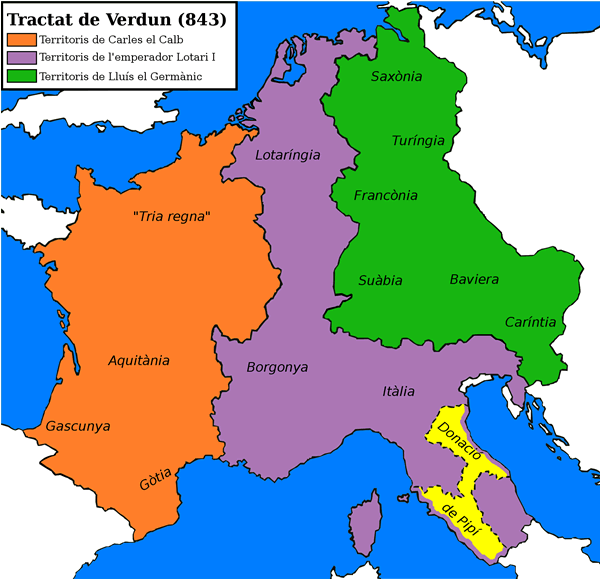The Treaty of Verdun, which was signed in 843, was the second step toward the dissolution of the Carolingian dynasty. It created the idea of nation-states. After Emperor Charlemagne died in 814 his sole surviving legitimate son Louis I the Pious (778–840) inherited his vast empire and became emperor of the west.
Louis had three sons by his wife, Ermengarde (778–818): Lothair (795–855), Pepin (797–838), and Louis (804–876). None of Charlemagne’s heirs possessed the leadership qualities of their grandfather.
Lothair, as the eldest, was named coemperor and became the primary heir of Louis at the Assembly of Aachen in 817. Louis I named Pepin I as the king of the Aquitaine and Louis as king of Bavaria, believing this would provide an orderly succession.
  |
The succession evolved into a dynastic crisis when Louis I married Judith of Bavaria in 820 and they had a son, Charles the Bald (823–877). Louis I wished to change the dynastic succession to favor Charles and in 830 granted Charles some of the lands that had been part of the inheritance of Lothair and Pepin, who now felt threatened. In 830 Lothair revolted and became sole ruler of his father’s empire.
Fearing Lothair’s overlordship, Pepin and Louis restored their father to power. In 833 Louis met Lothair on the Field of Lies near Colmar, Alsace, to arrange a settlement. However all three sons met him and Louis once again was deposed. Pepin and Louis I again allied against Lothair and restored their father to power in 834.
The inheritance issue remained problematic for the last few years of the lengthy reign of Louis. Soon before Pepin died, Louis proposed another partition in 837 and gave the Aquitaine, present-day southern France, to Charles. Pepin’s son, Pepin II; Lothair; and Louis rejected this decision.
When Louis died in 840 the inheritance issue remained unresolved. Civil war ensued among the brothers and severely weakened the prestige of both Crown and empire; consequently the aristocracy gained greater power.
The agreement finally to settle the issue militarily at Fontenoy-en-Puisaye, near Autun in Burgundy, in 842 led Louis and Charles to ally against Lothair and Pepin II, who decisively lost the battle. The outcome was the Oath of Strasbourg in 842 in which Charles and Louis once again allied against Lothair.
After much consideration the Treaty of Verdun on the Meuse was signed in August 843. The treaty partitioned the empire for the second time. Lothair retained his imperial title and received a long strip of land in the middle of Charlemagne’s empire known as Francia Media, extending from the North Sea to the Mediterranean, including present-day Lorraine, Provence, Burgundy, and the northern half of Italy.
Louis received Francia Orientalis, the eastern part of the empire, now Germany, and he became known as Louis the German—many historians consider him the founder of the German nation. Charles received Francia Occidentalis, most of present-day France.
The Treaty of Verdun represented the Frankish practice of divisible inheritance rather than the primogeniture inheritance practiced elsewhere. The Treaty of Mersen in 870 further divided Lothair’s lands among Charles the Bald, Louis the German, and his son, Louis II. This last treaty completely dissolved Charlemagne’s hard-won kingdom.
